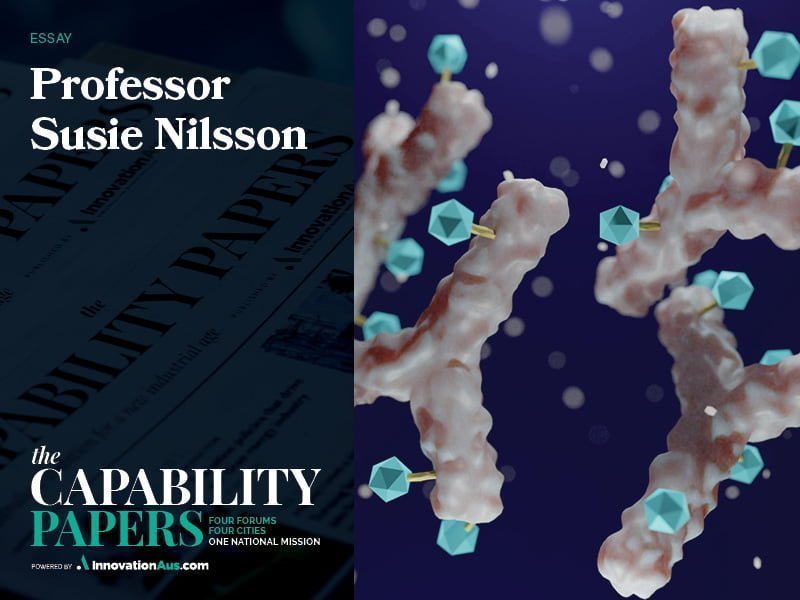One of the emerging areas in biologics translation over the past decade is in bioconjugation – a chemical technique used to stabily couple two molecules together, one of which is a biomolecule.
To ensure we can continue to assist the BioTech ecosystem to translate innovation into reality, CSIRO has developed significant expertise and capabilities melding biology and chemistry.
For example, at CSIRO’s National Vaccine and Therapeutics Laboratory, we work with industry and research collaborators to design, develop, scale up and produce bioconjugates so our partners can progress to clinical trials.
So far, we’ve been working on nanoparticle synthesis, and the design, development and production of the polymers used in nanoparticle stabilisation. The potential for innovation through bioconjugation is immense, and we’re at the starting point.

Underpinning all our expertise is the ability to analyse and characterise each of these types of materials, from small molecules and biotherapeutic biologics, to polymer, nanoparticles, and conjugates. When analysing the materials made under the relevant Quality Management Systems we can deliver a validated analytical product profile which is required for use of these materials in clinical studies.
Two recent case studies highlight both the breadth and depth of CSIRO’s capabilities, but also the impact of this emerging area of translational science:
An orally delivered insulin for children with Type 1 Diabetes
It is much easier to administer insulin orally to children with Type 1 Diabetes than it is to inject it. CSIRO has been working with the University of Sydney – that has now spun out an SME, Endo Axiom – on a multidisciplinary project focussed on developing a bioconjugated nanoparticle containing orally deliverable insulin aimed at treating children with Type 1 Diabetes.
The spinout now has $2.2 million in commercial backing. CSIRO delivered the proof-of-concept project and a scaled-up batch for toxicology studies is currently underway. The next step will be the production of materials for use in clinical trials.
The technology involves the use of metal nanoparticles, covalently conjugated to insulin, and coated with a polymer for stabilisation. Importantly, characterisation of the bioconjugate demonstrates the particles are stable, and there is controlled release of insulin.
A new treatment for ovarian cancer
CSIRO scientists recently delivered our first Good Manufacturing Practice (GMP) grade antibody drug conjugates to be used in clinical trials for treating ovarian cancer. This work is supported by a Medical Research Future Fund (MRFF) grant awarded to CSIRO and the University of Queensland. In this context, the antibody drug conjugate is a theranostic – an agent that can possess either a diagnostic or therapeutic modality and involves an antibody-chelator conjugate.
Successful delivery of this project involved optimising the conjugation chemistry, design and development of process scale up, purification and analysis of the conjugates before the production of GMP batches of the antibody for use in conjugation reactions.
As this is an emerging field, there are several gaps and opportunities in bioconjugate research. One significant opportunity is in formulation, which involves determining the ideal solution for ensuring delivery of the most bioactive conjugated biologic. Optimal, robust, formulation of straight biologics is not straightforward, and the addition of a conjugation component significantly increases this challenge due to the presence of commonly large, complex molecules.
Currently we are building an automated formulation laboratory, to enable the rapid testing of an array of existing and novel formulations in new projects, allowing additional optimisation for the successful delivery of biologics in clinical trials.
A second significant gap is the chemical linkers within the bioconjugates themselves, which are instrumental to the overall success of the antibody-drug conjugate. To ensure optimal bioactivity and stability of antibody-drug conjugates we are currently developing improved chemical linkers both within CSIRO and with external clients.
CSIRO’s success is driven by our engagement with Australian BioTech and MedTech companies and assisting them in their growth strategies. Their growth is our success. We work with these companies to develop new products or processes for the biomedical sector from medical devices, diagnostics, drugs, vaccines and efficient processes to produce these products.
These products can require pure chemistry, pure biology, and products involving bioconjugates, biosensors and modified surfaces sit at the intersection and draw from both scientific disciplines – this core capability is needed to drive the Australian BioTech and MedTech industry towards commercial success.
CSIRO regularly engages with both SMEs and spinout companies, to assist in the translation pathway. We work with them to develop robust processes that allow the translation from the R&D lab to a scaled-up quality management system process that ultimately moves the SME along the commercialisation pathway.
We provide them with materials, or devices for use in clinical trials or enable the SME to achieve a proof-of-concept step to attract further funding or to sell on their IP to progress the product through towards commercialisation.
Professor Susie Nilsson is the Research Director for the Biomedical Manufacturing program at Australia’s national science agency, CSIRO. Her portfolio encompasses the production of new products and processes for the biomedical sector – medical devices, diagnostics, drugs, vaccines, and efficient processes to produce them. Susie has an extensive history in biologics and specifically haematopoietic stem cell research. She completed her PhD at Melbourne University and post-doctoral studies at the University of Massachusetts prior to taking up a position at the Peter MacCallum Cancer Institute then the Australian Stem Cell Centre before moving to CSIRO in 2009.
Do you know more? Contact James Riley via Email.

